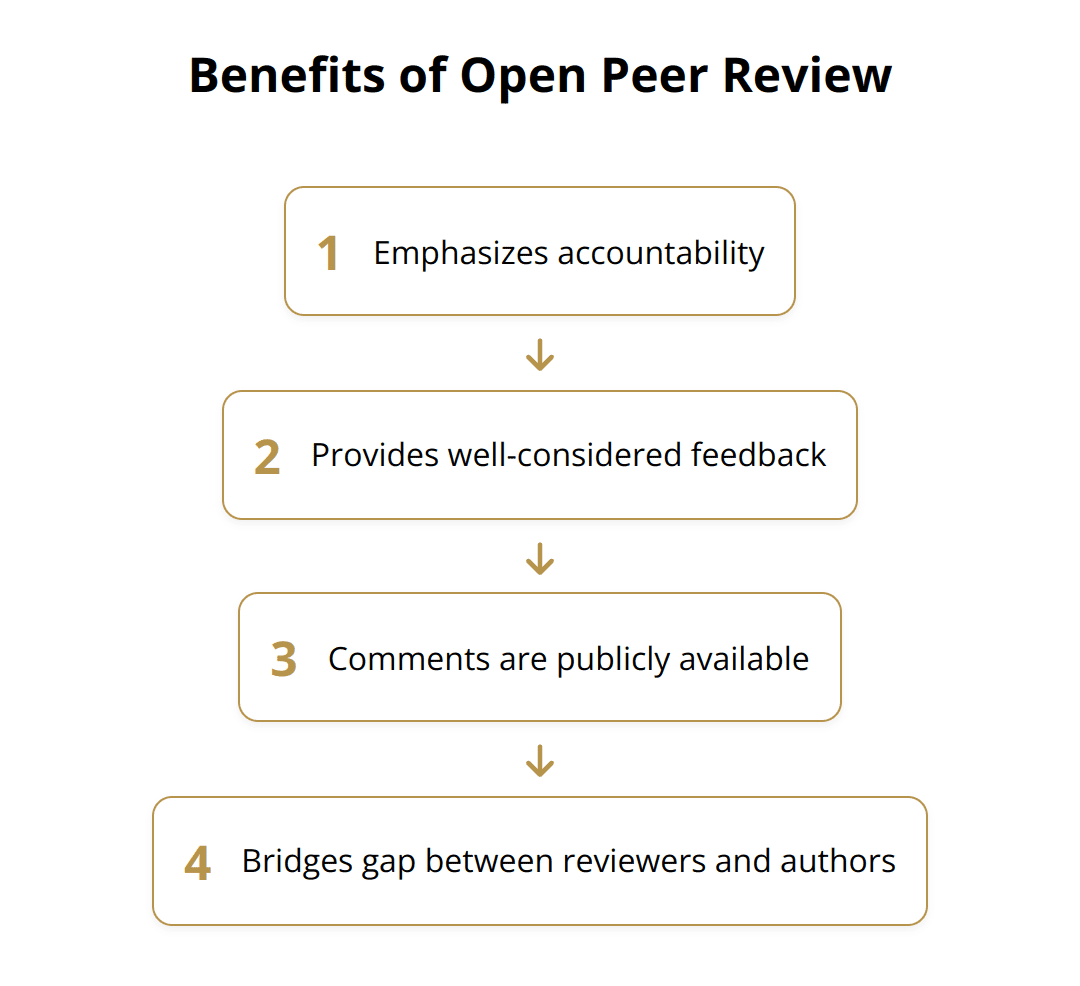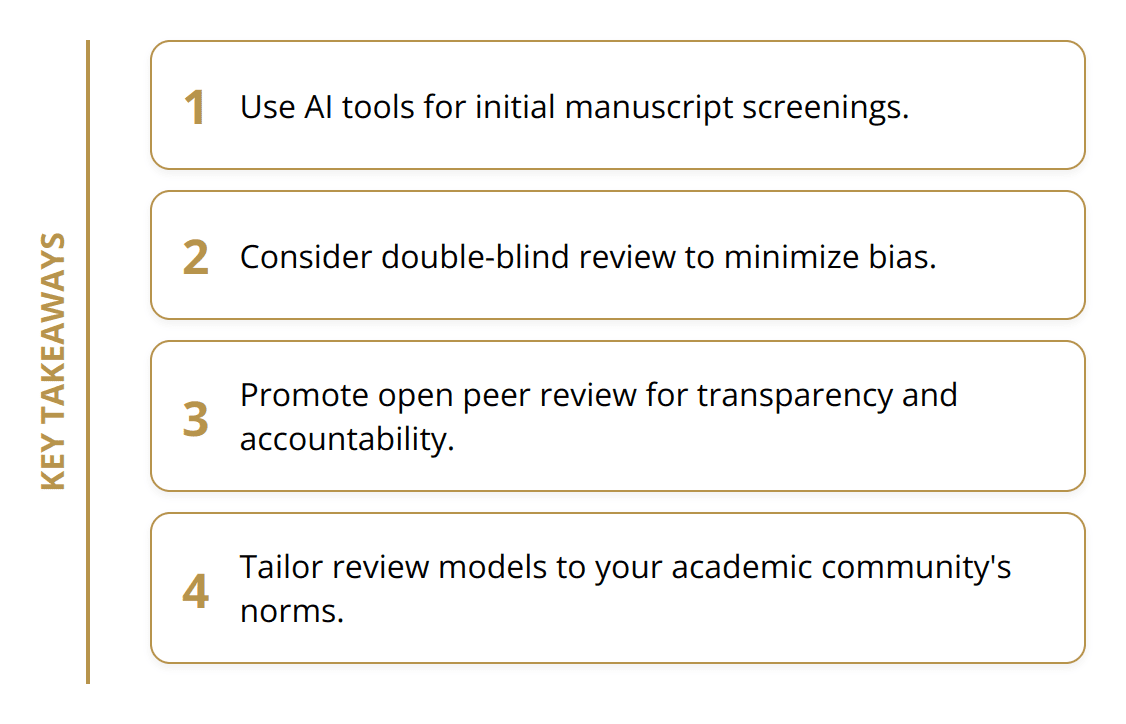Peer review is a cornerstone of academic publishing, ensuring the quality and credibility of scholarly work.
Different models of peer review offer varying levels of transparency and anonymity, each with its own benefits and drawbacks.
At Beverly Hills Publishing, we explore the nuances of single-blind, double-blind, and open peer review, along with their implications for authors and publishers.
Understanding these models can help navigate the evolving landscape of academic publishing.
What Are the Main Peer Review Models?
Single-blind, double-blind, and open peer review are common models employed in academic publishing. Each of these presents distinct advantages and challenges. Here’s an in-depth look at how these models function and how they impact authors and publishers.
Single-Blind Peer Review
In a single-blind review, the reviewers know the identity of the authors, but the authors do not know the identity of the reviewers. This model is widely used across many disciplines.
Benefits:
-
Transparency: Reviewers can provide more honest feedback without fearing repercussions.
-
Efficiency: Knowing the author’s background can help reviewers evaluate the context of the research more accurately.
Drawbacks:
-
Potential Bias: Knowing the author’s identity can introduce bias, whether conscious or unconscious.
-
Limited Anonymity for Authors: Authors may feel that their reputation is at stake, impacting their willingness to submit groundbreaking or unconventional research.
Double-Blind Peer Review
In this model, neither the authors nor the reviewers know each other’s identities. Double-blind peer review is common in social sciences and humanities.
Benefits:
-
Reduced Bias: By keeping identities concealed, it minimizes potential biases based on gender, university affiliation, or academic reputation.
-
Focus on Content: Ensures that the manuscript is judged solely on the quality of the research, without any preconceived notions about the author’s credentials.
Drawbacks:
-
Challenge of True Anonymity: In niche fields, it may still be possible to guess the identity of the authors based on writing style or research topic.
-
Time-Consuming: The double-blind process may take longer as it involves more steps to maintain anonymity.

Open Peer Review
Open peer review is where the identities of both the authors and the reviewers are known to each other. Some platforms even publish the reviews alongside the article.
Benefits:
-
Transparency and Accountability: This model promotes transparency and holds reviewers accountable for their comments and judgments.
-
Constructive Feedback: Knowing that the review will be public can encourage reviewers to provide more constructive and professional feedback.
Drawbacks:
-
Potential Reluctance: Reviewers may be reluctant to criticize openly, especially if they know the authors personally or professionally.
-
Possible Intimidation: Less experienced authors might feel intimidated by open critiques from well-established researchers.
Tips and Trends
-
AI in Peer Review: AI tools like Penelope and SciScore are increasingly used to assist with screening methods in peer review.
-
Post-publication Review: Gaining popularity, this model allows for community input and critique even after publication, providing continuous quality check.

Each model has its pros and cons, and the choice often depends on the goals of the publishers and the expectations of the academic community.
For more information on relevant trends, check out our article on publishing technologies.
Advantages and Disadvantages
Single-Blind Review
The use of single-blind reviews helps streamline the process. Reviewers can evaluate research with knowledge of the author’s previous work, enabling context-based appraisal. However, the downside is the potential bias—reviewers might subconsciously favor well-known authors or institutions, undermining objectivity. As per Publons, 63% of researchers prefer single-blind peer reviews for their practicality and balance.

Double-Blind Review
Double-blind reviews excel at minimizing biases, focusing strictly on the content rather than the author’s identity. This model promotes a more equity-focused evaluation. However, in niche fields, authorship might still be guessable. According to an American Economic Association study, double-blind reviews can increase acceptance rates for female authors by 7%.
Open Peer Review
Open peer review’s transparency holds both reviewers and authors accountable, fostering integrity and constructive criticism. Yet, the potential for conflicts of interest exists, especially when reviewers might hesitate to provide critical feedback. Frontiers journals have noted that open peer review can lead to faster publication times, by nearly 20%, due to upfront accountability.
Practical Tips
-
Use AI Tools: Implement AI tools like SciScore to assist in initial screenings and reduce manual bias.
-
Promote Transparency: Open peer review encourages accountability, but balancing transparency with genuine critique is crucial.
-
Understand Field Norms: Tailor the review model to what your specific academic community values most, whether it’s rigorous anonymity or open dialogue.

For further insights, explore how innovative publishers are leveraging advanced technologies in peer reviews.
What Are the Current Trends in Peer Review Publishing?
Growing Popularity of Open Peer Review
The rise of open peer review is significant. Studies show that transparency in peer review can speed up the publication process by nearly 20%, according to Frontiers journals. Open peer review emphasizes accountability, pushing reviewers to provide well-considered, constructive feedback since their comments are publicly available. This approach bridges the gap between reviewers and authors, making the review process more collaborative and interactive.

Integration of Technology in Review Processes
Technological advancements are revolutionizing the peer review landscape. AI tools like Penelope and SciScore are used to screen manuscripts for methodological rigor and compliance with journal guidelines. These tools can significantly reduce the workload of human reviewers, allowing them to focus on the quality and originality of the research. According to a report by the International Network for the Availability of Scientific Publications, the use of AI in peer review increased by 15% in 2023.
Shift Towards Transparency and Accountability
Transparency is not just a trend; it’s becoming an expectation. Journals are adopting more open peer review models, motivated by the need for credibility and fairness. For instance, the American Psychological Association has reported a 12% increase in the adoption of transparent peer review practices over the past two years. This shift also aligns with the ethical guidelines promoted in the industry, encouraging honest and constructive critiques.
Practical Tips:
-
Adopt AI Tools: Using tools like Penelope can streamline initial reviews, addressing common issues early in the process.
-
Promote Transparent Practices: Open review models can foster integrity and faster publication times.
-
Focus on Accountability: Transparent peer review encourages responsible and ethical feedback from reviewers.
For those interested in the evolving publishing technologies, read more about publishing technologies.
Conclusion
Peer review remains a cornerstone of academic publishing, with single-blind, double-blind, and open peer review models each offering unique advantages and challenges. Single-blind reviews provide efficiency and transparency but risk bias. Double-blind reviews minimize bias and emphasize content, though true anonymity is difficult in specialized fields. Open peer reviews promote transparency and accountability but can intimidate less experienced authors.

For authors, choosing the right model impacts how their work is evaluated and received. Publishers must balance the need for rigor and fairness in the review process. Leveraging AI tools like Penelope and SciScore can streamline initial reviews and maintain quality control.
Looking ahead, trends like increased transparency and the integration of technology will shape peer review practices. The emphasis on accountability and openness continues to grow, with more journals adopting these models. As these practices evolve, authors and publishers can expect ongoing improvements in efficiency and fairness.
By embracing these trends, we at Beverly Hills Publishing help authors not only publish their work but also enhance their professional brand. Discover more about our innovative approach to publishing and branding here.















































































































































































































































